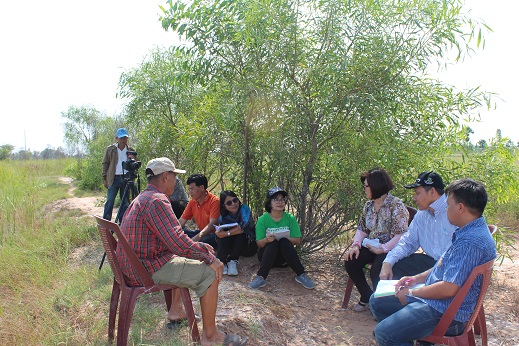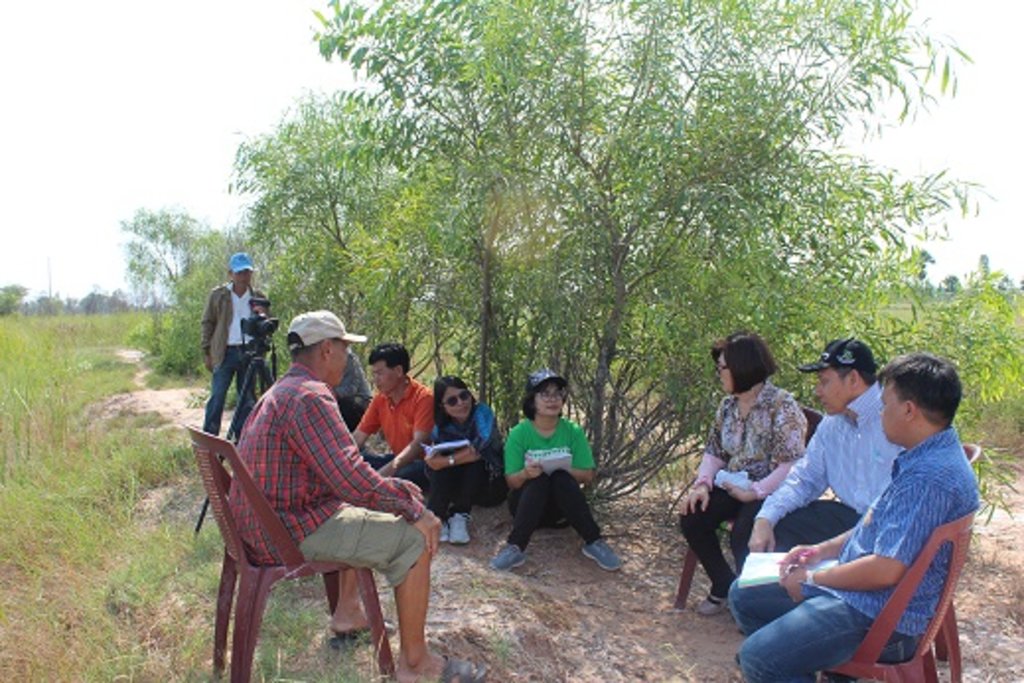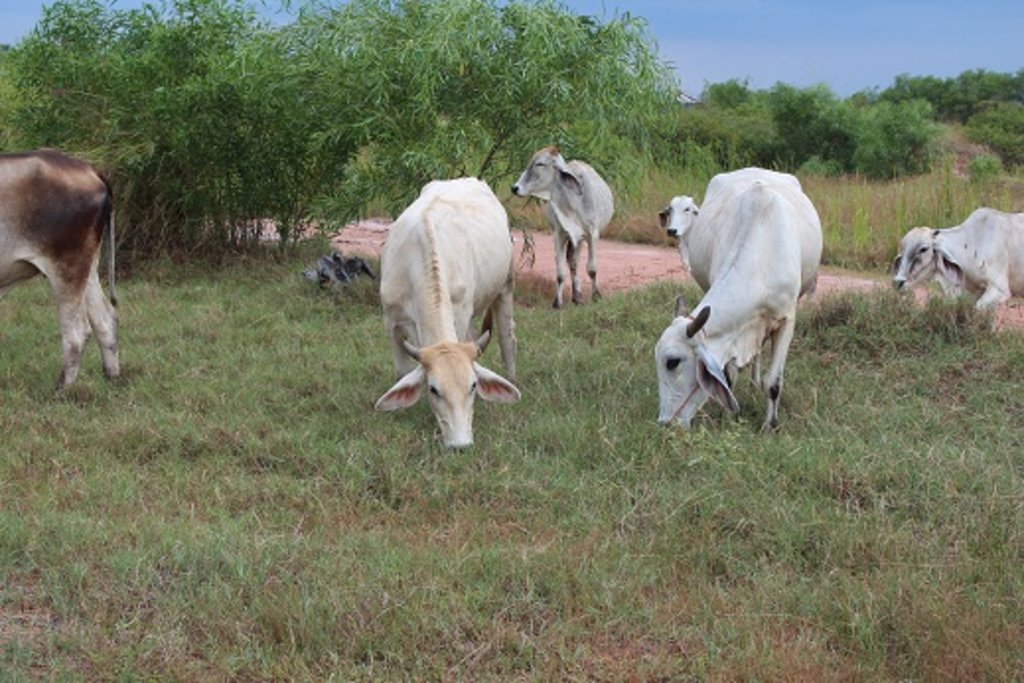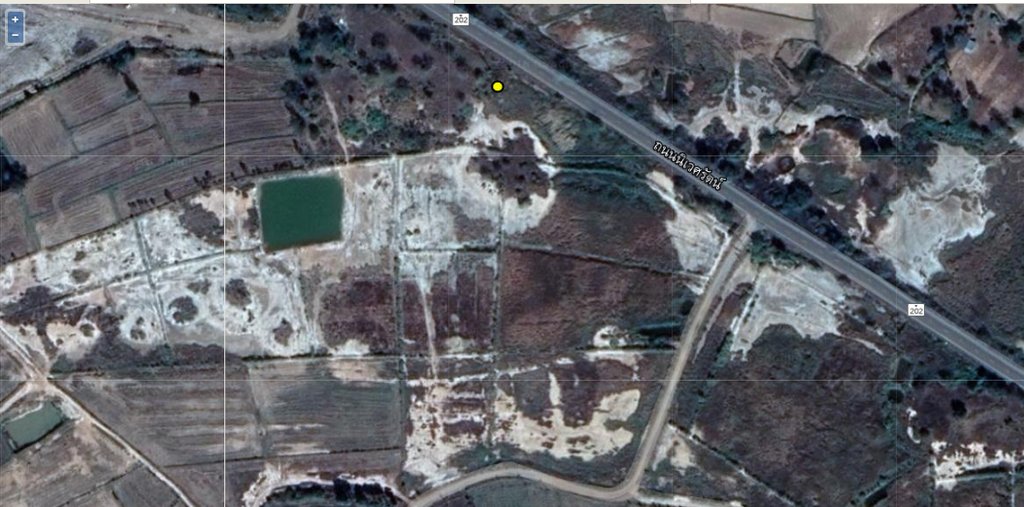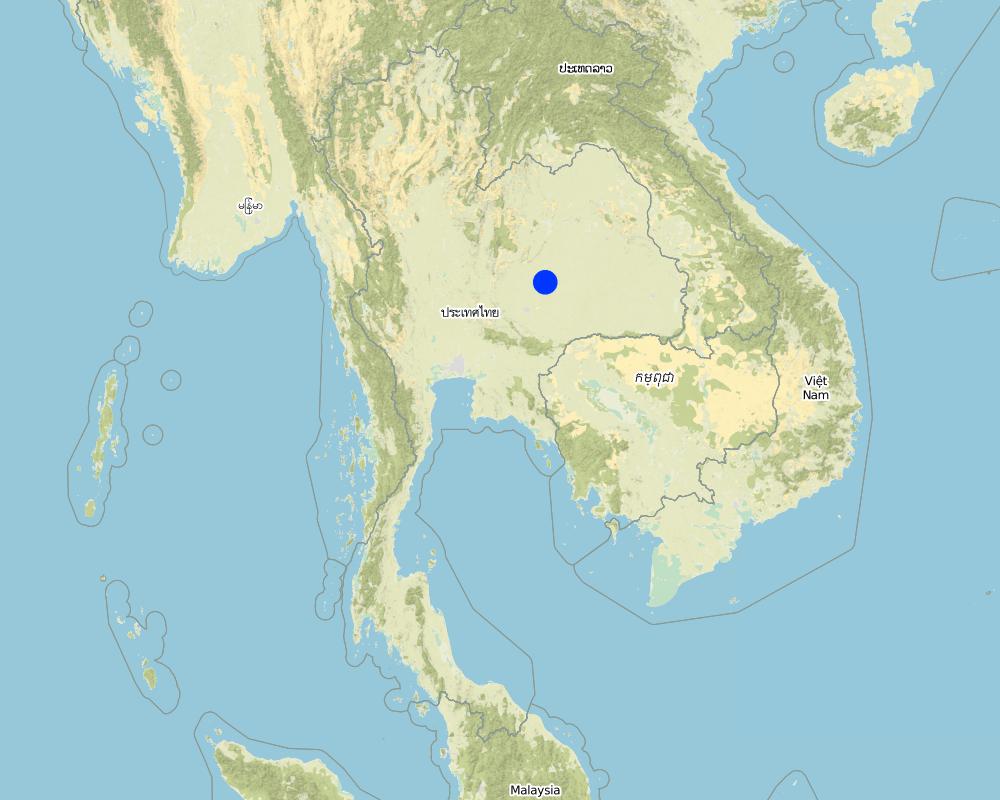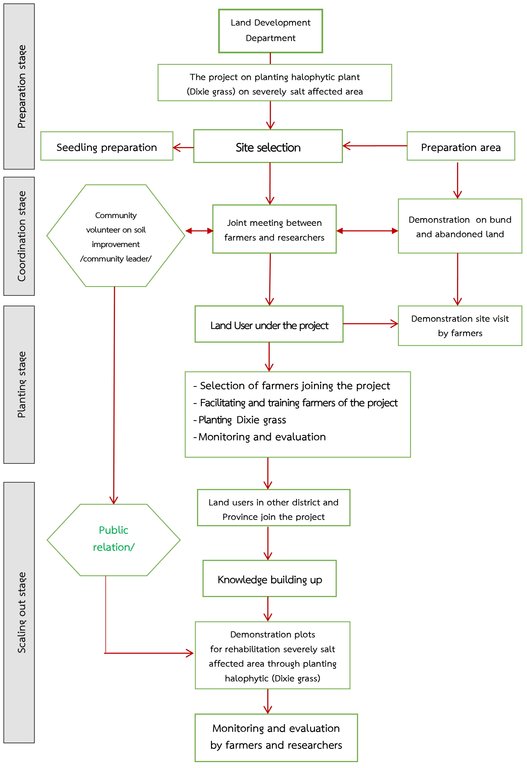Vegetative approach by using halophyte (Dixie grass) to control severely salt-affected land. [Thaïlande]
- Création :
- Mise à jour :
- Compilateur : Kamontip Sasithorn
- Rédacteur : –
- Examinateurs : Samran Sombatpanit, Rima Mekdaschi Studer, Alexandra Gavilano
approaches_4210 - Thaïlande
Voir les sections
Développer tout Réduire tout1. Informations générales
1.2 Coordonnées des personnes-ressources et des institutions impliquées dans l'évaluation et la documentation de l'Approche
Personne(s) ressource(s) clé(s)
exploitant des terres:
Yooburi Somsak
+66-80-7240599
10 Moo 12, Ban Kut Chok, Kut Chok Sub-district, Buayai District, Nakhon Ratchasima Province 30120
Thaïlande
exploitant des terres:
Sriwootpong Rungariam
+66-93-4613289
107 Ban Donpae Moo 8, Kut Chok Sub-district, Buayai District, Nakhon Ratchasima Province
Thaïlande
Department of Agricultural Extension officer:
Auonpokang Chiwat
+66-85-7783258
Buayai District Agricultural Extension Office
49 Buayai Sub-district, Buayai District, Nakhon Ratchasima Province 30120
Thaïlande
exploitant des terres:
Kumtisong Noorian
+66-62-1524591
45 Moo 10, Dang-chang Sub-district, Buayai District, Nakhon Ratchasima Province 30120
Thaïlande
Spécialiste GDT:
Spécialiste GDT:
Spécialiste GDT:
Spécialiste GDT:
National consultant:
Nom du projet qui a facilité la documentation/ l'évaluation de l'Approche (si pertinent)
Book project: where the land is greener - Case Studies and Analysis of Soil and Water Conservation Initiatives Worldwide (where the land is greener)Nom du projet qui a facilité la documentation/ l'évaluation de l'Approche (si pertinent)
Book project: where the land is greener - Case Studies and Analysis of Soil and Water Conservation Initiatives Worldwide (where the land is greener)Nom du ou des institutions qui ont facilité la documentation/ l'évaluation de l'Approche (si pertinent)
Land Development Department LDD (Land Development Department LDD) - Thaïlande1.3 Conditions relatives à l'utilisation par WOCAT des données documentées
Quand les données ont-elles été compilées (sur le terrain)?
18/10/2018
Le compilateur et la(les) personne(s) ressource(s) acceptent les conditions relatives à l'utilisation par WOCAT des données documentées:
Oui
1.4 Références au(x) questionnaire(s) sur les Technologies de GDT
2. Description de l'Approche de GDT
2.1 Courte description de l'Approche
The government promotes halophytes (Dixie grass) to control severely salt-affected land, rehabilitate the ecosystem and prevent the spread of salt in soil under cooperation of land owners, livestock farmers, local administration, local government agency, Land Development Department researchers and with specialists/ technical advisors in various fields.
2.2 Description détaillée de l'Approche
Description détaillée de l'Approche:
Ministry of Agriculture and Cooperatives by Land Development Department (LDD) had initiated the project on planting salt-tolerant tree and grass on severely salt-affected land in the Northeast of Thailand since 1996. The project had facilitated planting halophyte (Dixie grass) on salt-crusted and barren land since then. The main objectives of approach were to promote the land users to maximize land use for farming, prevent the forming of extensive severely saline soil, to use halophyte (Dixie grass) as cover crop and rehabilitate the ecosystem of severely salt-affected soil. The activities started with public hearing, identifying severely salt-affected areas, set demonstration plot on the farmer’s land as learning center and communication with local administration to call for farmers meeting with detailed work plan and discussion of strengths, weaknesses, opportunities, and threats of planting Dixie grass. The implementing activities consisted of 4 stages; the PREPARATION STAGE was for seedling preparation, site selection of severely salt-affected soil and land preparation, public hearing and establishment of the demonstration plot at Dan Chang Sub-district, Buayai District, Nakhon Ratchasima Province. The COORDINATION STAGE included joint meeting between farmers and researchers, joint monitoring & evaluation and follow up and land users' decision-making. The PLANTING STAGE started from selection of farmers joining the project, facilitating and training farmers, site visit to the demonstration plot, which is the model of planting method established under the project on planting salt-tolerant tree and grass on severely salt-affected land in the Northeast of Thailand. The FINAL ACTIVITY OF SCALING-OUT STAGE: the land users/ farmers favoured this project; after 3 years of planting Dixie grass it was found this barren land became covered by plants and much improved in biodiversity by the evidence of many varieties of wild grasses and flowers, dragonflies, rats and birds. Farmers could now grow rice and they used Dixie grass as feed for livestock. Moreover, and attractively, farmers were able to increase their income. The migration for job to big cities was reduced. The stakeholders were land owners, livestock farmers, local administration, local government agency, researchers and SML specialists from LDD - all worked together with mutual benefit. Although planting halophytes was an improvement method (of vegetative measure) of severely saline soil with low input, the recovery/accomplishment time (in saline soil improvement) could not be as fast as that of the engineering measure with much higher investment.
2.3 Photos de l'approche
2.4 Vidéos de l'Approche
Date:
18/10/2018
Lieu:
6 Ban Donpae Moo 8, Kut Chok Sub-district, Buayai District, Nakhon Ratchasima Province
2.5 Pays/ région/ lieux où l'Approche a été appliquée
Pays:
Thaïlande
Région/ Etat/ Province:
Nakhon Ratchasima Province
Autres spécifications du lieu :
6 Ban Donpae Moo 8, Kut Chok Sub-district, Buayai District
Map
×2.6 Dates de début et de fin de l'Approche
Indiquez l'année de démarrage:
2015
Date (année) de fin de l'Approche (si l'Approche n'est plus appliquée):
2016
2.7 Type d'Approche
- fondé sur un projet/ programme
2.8 Principaux objectifs de l'Approche
The main objectives of the approach were to promote the land users to maximize land use for farming, to prevent the forming of extensive severely saline soil, to use halophyte (Dixie grass) as cover crop and to rehabilitate the ecosystem of severely salt-affected soil.
2.9 Conditions favorisant ou entravant la mise en œuvre de la(des) Technologie(s) appliquée(s) sous l'Approche
normes et valeurs sociales/ culturelles/ religieuses
- favorise
The land users follow what their neighbours practice.
disponibilité/ accès aux ressources et services financiers
- favorise
Through the Bank for Agriculture and Agricultural Cooperatives.
cadre institutionnel
- favorise
Local administration
collaboration/ coordination des acteurs
- favorise
Coordination of soil doctor volunteers and community leaders in the area.
cadre politique
- favorise
The government has the policy to prevent soil degradation.
connaissances sur la GDT, accès aux supports techniques
- favorise
To provide knowledge to land users in the area.
charge de travail, disponibilité de la main-d'œuvre
- favorise
For land users under the project
- entrave
For land users outside the project
3. Participation et rôles des parties prenantes impliquées dans l'Approche
3.1 Parties prenantes impliquées dans l'Approche et rôles
- exploitants locaux des terres / communautés locales
Farmers under the project
Planting halophytes (Sporobolus verginicus - Dixie grass)
- organisations communautaires
Local administration (Sub-district Administration Organization)
Call for meeting
- Spécialistes de la GDT/ conseillers agricoles
Land Development Department
Site selection
- chercheurs
Land Development Department
Provide technical recommendations
- gouvernement national (planificateurs, décideurs)
Land Development Department
Funding, planner, decision-makers
3.2 Participation des exploitants locaux des terres/ communautés locales aux différentes phases de l'Approche
| Participation des exploitants locaux des terres/ communautés locales | Spécifiez qui était impliqué et décrivez les activités | |
|---|---|---|
| initiation/ motivation | interactive | Land users in the project based |
| planification | passive | Discussion with land users on work plan before starting the activity. |
| mise en œuvre | soutien extérieur | Land users/farmers in the project |
| suivi/ évaluation | soutien extérieur | Land users in the project |
3.3 Diagramme/ organigramme (si disponible)
Description:
Four stages of participating process of technology development among organizations, community volunteers on soil improvement, farmers, SML specialists and researchers.
Auteur:
Kamontip Sasithorn
3.4 Prises de décision pour la sélection de la Technologie/ des Technologies
Indiquez qui a décidé de la sélection de la Technologie/ des Technologies à mettre en œuvre:
- principalement les spécialistes de la GDT, après consultation des exploitants des terres
Spécifiez sur quelle base ont été prises les décisions:
- l'évaluation de connaissances bien documentées en matière de GDT (prises de décision fondées sur des preuves tangibles)?
4. Soutien technique, renforcement des capacités et gestion des connaissances
4.1 Renforcement des capacités/ formation
Une formation a-t-elle été dispensée aux exploitants des terres/ autres parties prenantes?
Oui
Spécifiez qui a été formé:
- exploitants des terres
Formats de la formation:
- zones de démonstration
- réunions publiques
Thèmes abordés:
Prevention and rehabilitation of salt-affected land with available technology and increased income for farmers.
4.2 Service de conseils
Les exploitants des terres ont-ils accès à un service de conseils?
Oui
Spécifiez si le service de conseils est fourni:
- dans les champs des exploitants?
Décrivez/ commentez:
1. Soil doctor volunteers represent the Land Development Department with duty in providing knowledge to farmers in the area.
2. SLM specialists from Land Development Department visited and advised farmers in the area.
4.3 Renforcement des institutions (développement organisationnel)
Des institutions ont elles été mises en place ou renforcées par le biais de l'Approche?
- non
4.4 Suivi et évaluation
Le suivi et l'évaluation font ils partie de l'Approche? :
Oui
Commentaires:
SLM specialists from Land Development Department collaborated with LDD soil doctor volunteers in surveying the survival rate and following up the growth of plants in the area.
Si oui, ce document est-il destiné à être utilisé pour le suivi et l'évaluation?
Oui
4.5 Recherche
La recherche a-t-elle fait partie intégrante de l’Approche?
Oui
Spécifiez les thèmes:
- technologie
Donnez plus de détails et indiquez qui a mené ces recherches:
The Soil Salinity Research Group, LDD, conducted research on "halophytes plantation and the flow path along the landscape in Northeast Thailand" with Dr. J.L. Gallagher from Delaware Biotechnology Institute, University of Delaware.
5. Financement et soutien matériel externe
5.1 Budget annuel de la composante GDT de l'Approche
Si le budget annuel précis n'est pas connu, indiquez une fourchette:
- < 2 000
Commentez (par ex. principales sources de financement/ principaux bailleurs de fonds):
Land Development Department
5.2 Soutiens financiers/ matériels fournis aux exploitants des terres
Les exploitants des terres ont-ils reçu un soutien financier/ matériel pour la mise en œuvre de la Technologie/ des Technologies?
Oui
Si oui, spécifiez le(s) type(s) de soutien, les conditions et les fournisseurs:
Dixie grass seedlings and land preparation cost
5.3 Subventions pour des intrants spécifiques (incluant la main d'œuvre)
- main d'œuvre
| Dans quelle mesure | Spécifiez les subventions |
|---|---|
| entièrement financé | Planting |
- autre
| Autre (spécifiez) | Dans quelle mesure | Spécifiez les subventions |
|---|---|---|
| seeding | entièrement financé | free seedings |
Si la main d'œuvre fournie par les exploitants des terres était un intrant substantiel, elle était:
- payée en espèces
Commentaires:
Labour by land users and employees; due to the landowner has insufficient labor for grass planting. Therefore, need to hire workers to grow by paying wages a day 175 THB/person (the minimum rate)
5.4 Crédits
Des crédits ont-ils été alloués à travers l'Approche pour les activités de GDT?
Non
5.5 Autres incitations ou instruments
D'autres incitations ou instruments ont-ils été utilisés pour promouvoir la mise en œuvre des Technologies de GDT?
Non
6. Analyses d'impact et conclusions
6.1 Impacts de l'Approche
Est-ce que l'Approche a autonomisé les exploitants locaux des terres, amélioré la participation des parties prenantes?
- Non
- Oui, un peu
- Oui, modérément
- Oui, beaucoup
Generate food security and family income.
Est-ce que l'Approche a permis la prise de décisions fondées sur des données probantes?
- Non
- Oui, un peu
- Oui, modérément
- Oui, beaucoup
Establish learning center for farmers as an information for technology adoption.
Est-ce que l'Approche a aidé les exploitants des terres à mettre en œuvre et entretenir les Technologies de GDT?
- Non
- Oui, un peu
- Oui, modérément
- Oui, beaucoup
Farmers well adopted the technology, resulting in the expansion of such Approach to a wider area.
Est-ce que l'Approche a amélioré les connaissances et les capacités des exploitants des terres pour mettre en œuvre la GDT?
- Non
- Oui, un peu
- Oui, modérément
- Oui, beaucoup
Farmers have adapted and changed SLM model to suit their own preference.
Est-ce que l'Approche a conduit à améliorer la sécurité alimentaire et/ou la nutrition?
- Non
- Oui, un peu
- Oui, modérément
- Oui, beaucoup
Farmers can grow rice and they use Dixie grass as feed for livestock.
Est-ce que l'Approche a conduit à des emplois, des opportunités de revenus?
- Non
- Oui, un peu
- Oui, modérément
- Oui, beaucoup
The migration for job to big cities has reduced.
6.2 Principale motivation des exploitants des terres pour mettre en œuvre la GDT
- augmenter la production
From the interview, farmers were satisfied with this technology of Sporobolus virginicus planting to rehabilitate severely saline soil. Besides being lower in salination farmers got more rice yields and better environment and livelihoods.
- réduire la dégradation des terres
After 3 years of planting Dixie grass, it was found that the formerly barren land became covered by plants and much improved in biodiversity by the evidence of many varieties of wild grass, dragonflies, rats and birds.
6.3 Durabilité des activités de l'Approche
Les exploitants des terres peuvent-ils poursuivre ce qui a été mis en œuvre par le biais de l'Approche (sans soutien extérieur)?
- oui
Si oui, décrivez de quelle manière:
Farmers have better understanding and positive attitude of planting halophytes (Dixie grass). Moreover, they have more income generated from rice yield and livestocks, as farmers could now grow rice and used Dixie grass to raise livestock.
6.4 Points forts/ avantages de l'Approche
| Points forts/ avantages/ possibilités du point de vue de l'exploitant des terres |
|---|
| Soil doctor volunteer, local government agency and community leader were the coordinators in the area. |
| Farmers had easy access to markets and sources of Dixie grass seedlings. |
| Distribution of Dixie grass seedling was done at no cost. |
| Points forts/ avantages/ possibilités du point de vue du compilateur ou d'une autre personne ressource clé |
|---|
| A supported technique created to make better environment on severely saline soil in the Northeast of Thailand. |
| Technique in planting Dixie grass was provided continually by Land Development Department and community volunteers on soil improvement. |
| A demonstrated plot was established in the area. |
6.5 Faiblesses/ inconvénients de l'Approche et moyens de les surmonter
| Faiblesses/ inconvénients/ risques du point de vue de l’exploitant des terres | Comment peuvent-ils être surmontés? |
|---|---|
| Advertising of project was not extensive enough, particularly to the area of severely saline soil. | It is necessary for the Land Development Department to cooperate more closely with local administration to promote the project. |
| Faiblesses/ inconvénients/ risques du point de vue du compilateur ou d'une autre personne ressource clé | Comment peuvent-ils être surmontés? |
|---|---|
| Some farmers did not believe that Dixie grass was very salt tolerant and will make the salinity of the soil decrease after planting it. | The officers should build up knowledge from successful farmers by frequently visiting farmers in the area under the project "rehabilitation of severely salt-affected soil by planting Dixie grass". |
7. Références et liens
7.1 Méthodes/ sources d'information
- interviews/entretiens avec les exploitants des terres
- interviews/ entretiens avec les spécialistes/ experts de GDT
7.2 Références des publications disponibles
Titre, auteur, année, ISBN:
Land Development Department
Disponible à partir d'où? Coût?
http://www.ldd.go.th/
7.3 Liens vers les informations pertinentes disponibles en ligne
Titre/ description:
where the land is greener - Case Studies and Analysis of Soil and Water Conservation Initiatives Worldwide
URL:
https://www.wocat.net/library/media/27/
Titre/ description:
where people and their land are safer - A Compendium of Good Practices in Disaster Risk Reduction (DRR) (where people and their land are safer) URL:
URL:
https://www.wocat.net/en/projects-and-countries/projects/drr
Liens et modules
Développer tout Réduire toutLiens
Aucun lien
Modules
Aucun module trouvé


